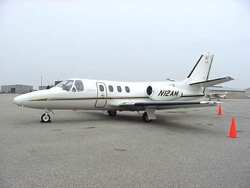Five Fatally Injured When The Bizjet Went Down On Approach
A missed approach and then a poor second landing attempt resulted in a accident which fatally injured five people on board a Cessna Citation (similar aircraft pictured in lower image) in Franklin, NC March 15th. In its preliminary report, the NTSB indicates that the pilot held the proper ratings for the jet, and 185 hours in the accident airplane. The weather was reported to be VFR at the time of the accident.

NTSB Identification: ERA12FA225
14 CFR Part 91: General Aviation
Accident occurred Thursday, March 15, 2012 in Franklin, NC
Aircraft: CESSNA 501, registration: N7700T
Injuries: 5 Fatal.
This is preliminary information, subject to change, and may contain errors. Any errors in this report will be corrected when the final report has been completed.
On March 15, 2012, about 1350 eastern daylight time, a Cessna 501, N7700T, operated by a private individual, was substantially damaged while landing at Macon County Airport (1A5), Franklin, North Carolina. The certificated private pilot and four passengers were fatally injured. The personal flight was conducted under the provisions of 14 Code of Federal Regulations Part 91. Visual meteorological conditions prevailed and an instrument flight rules flight plan was filed for the flight that departed from Venice Municipal Airport (VNC), Venice, Florida, about 1150.
Two witnesses, one of which was a pilot, worked for a fixed-based-operator at 1A5 and were standing on the ramp area at the time of the accident. They reported that the airplane approached runway 25, a 5,001-foot long, 75-foot-wide, asphalt runway. The airplane was high during the approach, performed a go-around, and made a left turn for another approach. During the second approach, the airplane was high again and the approach steepened, nose-down onto the runway. The nosegear touched down approximately half-way down the runway, followed by main gear touchdown. The airplane then bounced and the witnesses heard the engine noise increase. It then banked right and the right wing contacted the ground. The airplane subsequently flipped over off the right side of the runway and a postcrash fire ensued.
The airplane came to rest in a grassy area, about 50 feet off the right side of the runway, approximately 4,250 feet beyond the approach end of runway 25. The wreckage was inverted and oriented about a magnetic heading of 350 degrees. Approximately 100 feet of skid marks were observed about 2,300 feet beyond the approach end of the runway, consistent with the left and right main landing gear tires. Another 55-foot skid mark was observed about 250 feet beyond the first skids, which was consistent with the left main landing gear tire. A postcrash fire consumed a majority of the cockpit and cabin.

The pilot, age 62, held a private pilot certificate with ratings for airplane single-engine land, airplane multiengine land, and instrument airplane. He also held a type rating for the Cessna 501. His most recent Federal Aviation Administration third-class medical certificate was issued on December 20, 2010. At that time, he reported a total flight experience of 1,100 hours. Review of the pilot's logbook revealed that he had accumulated approximately 185 hours in the accident airplane, which were flown during a 2-year period preceding the accident.
The eight-seat airplane, serial number 501-0248, was manufactured in 1982. It was powered by two Pratt and Whitney Canada JT15D-1B engines, each capable of generating 2,200 pounds of thrust.
The recorded weather at 1A5, at 1350, was: wind from 260 degrees at 3 knots; sky clear; visibility 10 miles; temperature 23 degrees C; dew point 7 degrees C, altimeter 30.28 inches of mercury.
 ANN's Daily Aero-Linx (04.16.24)
ANN's Daily Aero-Linx (04.16.24) Aero-News: Quote of the Day (04.16.24)
Aero-News: Quote of the Day (04.16.24) Airborne 04.10.24: SnF24!, A50 Heritage Reveal, HeliCycle!, Montaer MC-01
Airborne 04.10.24: SnF24!, A50 Heritage Reveal, HeliCycle!, Montaer MC-01 Airborne 04.12.24: SnF24!, G100UL Is Here, Holy Micro, Plane Tags
Airborne 04.12.24: SnF24!, G100UL Is Here, Holy Micro, Plane Tags Airborne-Flight Training 04.17.24: Feds Need Controllers, Spirit Delay, Redbird
Airborne-Flight Training 04.17.24: Feds Need Controllers, Spirit Delay, Redbird




